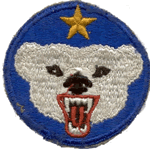World War II in the Aleutians - Shemya (APO 729)
January 26, 1943 to January 27, 1946
1. Recap of Army Facilities
Ft. Benjamine Harrison, Indiana
Ft. McClellan - Anniston, Alabama
Ft. Lawton - Seattle, Washington
4. Shemya
7. My Outfit
8. My Buddies
12. Potpourri
14. Coincidences
In it's organizational structure, the majority of Army units has a Supply
Room, manned by a Supply Sergeant and assistant(s). The many functions
it serves depends upon what sort of outfit it is part of, the number of men,
in the unit, and other local requirements.
As Supply Sergeant of our organization, my responsibility was to furnish
Army Tug Boats with their needs, requiring written authorization from
the ship's captain, and counter-signed by an officer in our unit. A formal
requisition was then typed up and depending on the nature of the items, trips
made to Quartermaster for clothes, Commissary for food, Ordinance for
armaments, Fuel depot for oil,
This required at least one assistant to keep the supply room open when either
one of us would remain while the other did the pick-up.
We tried to inventory certain basics to keep on hand, but space was always a
problem. Every person in the unit had a complete outfit, in his size, that was
permeated with protective coating in case of a chemical attack. This took up
room. Emergency cots, blankets, etc. had to be stored should a ship go
aground - and this happened once in a while. Sounds silly, but the most sought
after items were toilet paper and candles (before we had electricity).
We also serviced the sixty men in our outfit - - - - - twice a month on predetermined
days, everyone would bring their dirty clothes in barracks bags - well marked
and we would take the truckload to the base laundry and pick it up the next day.
Once a month was "Salvage Day". When an article was worn out, the supply room
examined it, kept records of the person and size of the article, then made a trip to
Quartermaster for replacement.It was a half-day drag, waiting in line, having the
articles examined again, then replenished from the bins. The reason for these exam's
was to determine whether the article wore out through ordinary use, or whether it
was helped along with a course rasp. If any hanky-pank was discovered, we were
required to fill out a statement of charges, with the dollar value, then submit it to
the company commander so that the amount would be deducted from the monthly pay.
This procedure was bypassed when items were lost or damaged in a battle zone.
Occasionally, when there was an alert of a possible attack, we rushed to the Ordinance
Depot to load up on grenades, munitions, etc. then stored them in the supply room
until the danger was gone.
I will end this segment by saying that the qualification which allowed me the promotion
to PFC, then corporal, then to sergeant, was my ability to type 40 words per minute.
